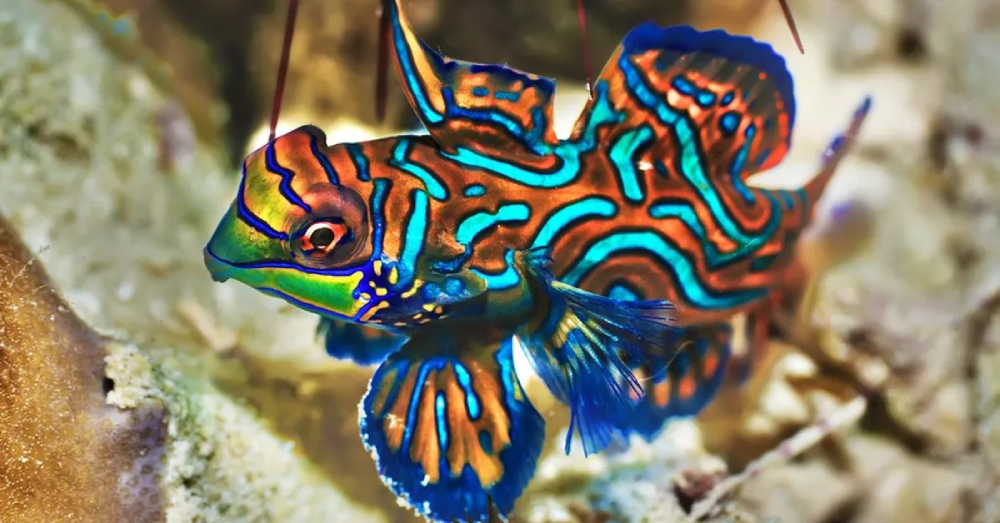The Mandarinfish, also known as Synchiropus splendidus, is one of the most spectacularly colored fish in the ocean. Its vibrant hues of blue, orange, and green make it a living gem within the coral reefs of the Pacific Ocean. This small, exotic fish has captivated the attention of marine biologists, aquarium enthusiasts, and divers alike due to its striking appearance and unique behaviors.
Habitat and Distribution
Mandarinfish are primarily found in the warm waters of the western Pacific Ocean. They particularly live around the reefs of the Philippines, Indonesia, and Australia. They prefer shallow, sheltered lagoons and inshore reefs, where they can weave in and out of coral crevices and rubble. The complex structures of coral reefs provide them with abundant hiding spots and a rich supply of food.
Physical Description
The Mandarinfish is renowned for its vivid coloration, which is due to cellular pigments called chromatophores. Unlike many other fish, the Mandarinfish does not have scales. Instead, it has a thick mucus-covered skin which gives it a somewhat slimy texture and provides protection against parasites and infections.
The Mandarinfish’s body is predominantly blue with wavy orange lines running across it. These lines are unique to each individual, much like a human fingerprint. Its fins are adorned with a mixture of blue, orange, and green, creating a fan-like display when extended. The male Mandarinfish is typically larger and has a more elongated dorsal fin compared to the female.

Behavior and Diet
Mandarinfish are known for their shy and reclusive nature. They are often found hiding among the corals during the day and become more active at dusk. This twilight period is when they engage in their most notable behavior—mating.
The Mandarinfish diet primarily consists of small crustaceans, worms, and other tiny invertebrates found within the coral reefs. They use their small mouths to pick food items off the substrate, a behavior that requires them to constantly forage to meet their dietary needs. In captivity, feeding Mandarinfish can be challenging, as they are often reluctant to accept prepared foods and require live or frozen foods that closely mimic their natural diet.
Reproduction
The mating dance of the Mandarinfish is a spectacular event that occurs at dusk. Males display their fins and colors to attract females. If a female is interested, she will join the male, and they will rise together into the water column to release their gametes simultaneously. This synchronous release increases the chances of fertilization and dispersal of the eggs away from predators on the reef.
After fertilization, the eggs float freely in the water and hatch into larvae after a few days. These larvae are planktonic, drifting with the currents until they settle onto the reef and begin their transformation into juvenile fish. This process is fraught with danger, as many larvae fall prey to various ocean predators.
Conservation Status
Currently, the Mandarinfish is not listed as endangered or threatened. However, their populations face pressures from habitat destruction, primarily due to coral reef degradation caused by climate change, pollution, and destructive fishing practices. Additionally, their popularity in the aquarium trade poses a threat. Wild-caught Mandarinfish often do not survive well in captivity due to the challenges in replicating their natural habitat and diet.
Efforts to breed Mandarinfish in captivity have met with some success, providing a more sustainable alternative to wild collection. These captive-bred individuals are generally hardier and better adapted to aquarium life.
Importance to the Ecosystem
Mandarinfish play a crucial role in the health of coral reef ecosystems. By feeding on small invertebrates and crustaceans, they help to maintain the balance of these populations, preventing any one species from becoming overly dominant. Their presence is also indicative of healthy reef systems, as they require well-structured coral habitats and clean water to thrive.
Fascination in Human Culture
The dazzling appearance of the Mandarinfish has made it a symbol of beauty and exoticism in various cultures. In the aquarium trade, they are highly sought after for their striking colors and patterns. Marine photographers and divers often consider sightings of Mandarinfish a highlight of their underwater experiences.
In traditional Asian cultures, fish with vivid colors are often associated with good fortune and prosperity. The Mandarinfish, with its jewel-like appearance, fits well into this symbolic framework, although it is not as widely recognized as other more common species like koi fish.
Conclusion
The Mandarinfish is a testament to the wonders of marine biodiversity, showcasing nature’s artistry in its brilliant colors and intricate behaviors. Protecting their natural habitats and promoting sustainable practices in the aquarium trade are essential for ensuring that future generations can continue to admire these magnificent creatures. As ambassadors of the coral reefs, Mandarinfish remind us of the delicate and interconnected web of life that thrives beneath the ocean’s surface.









